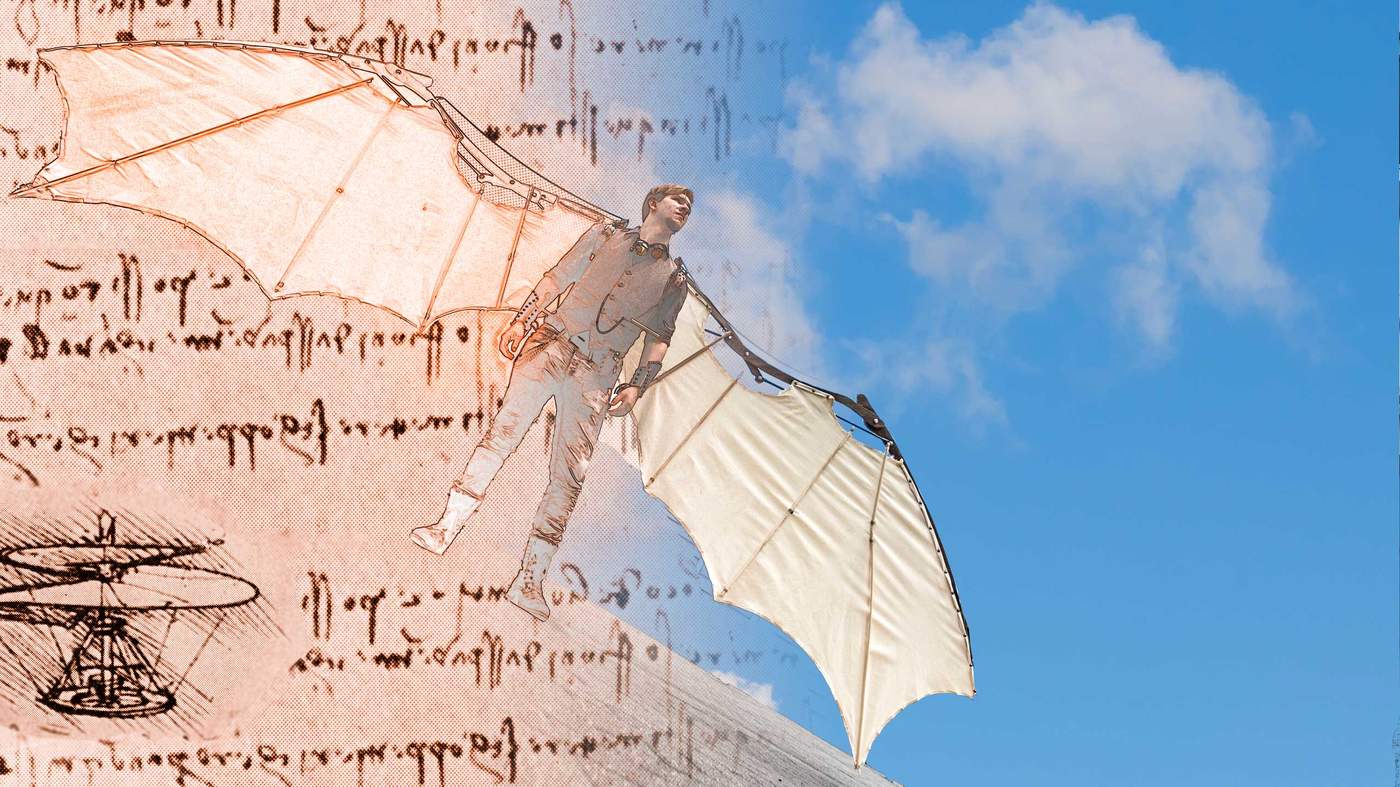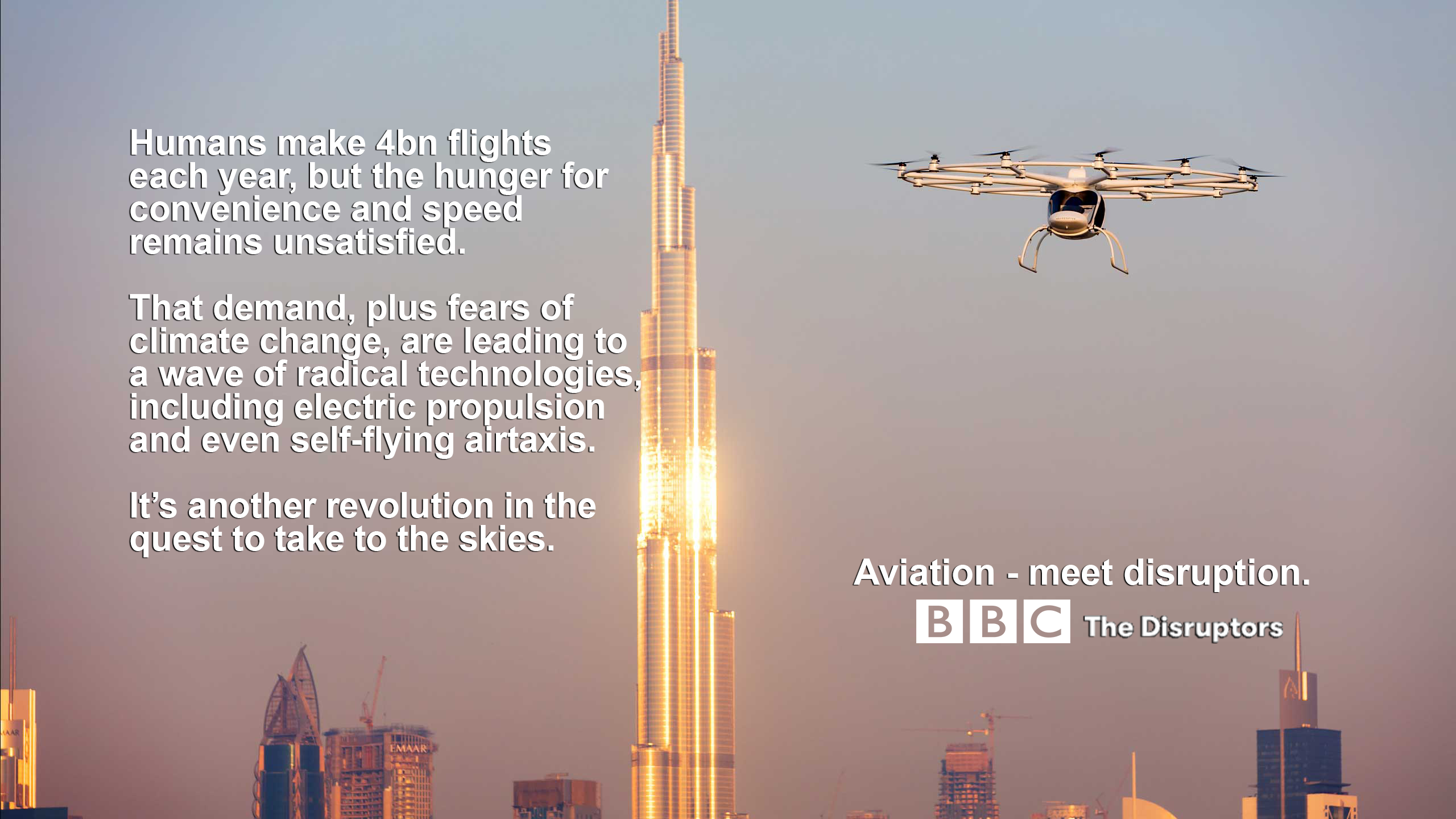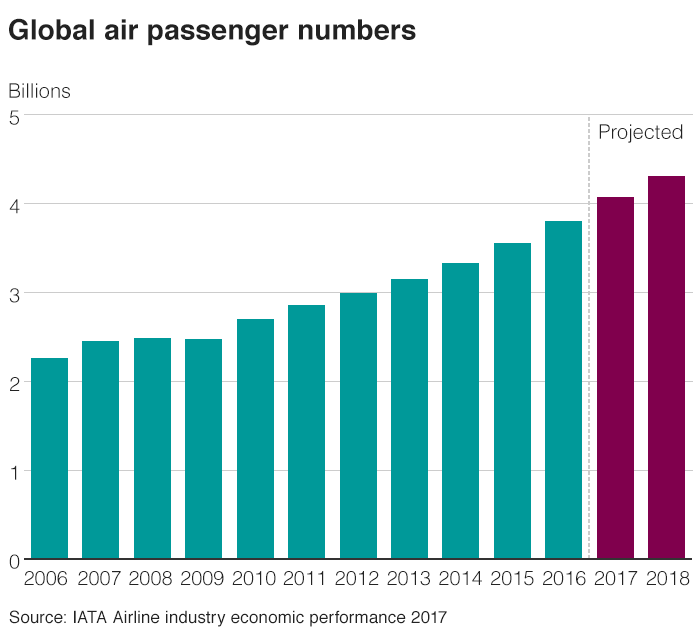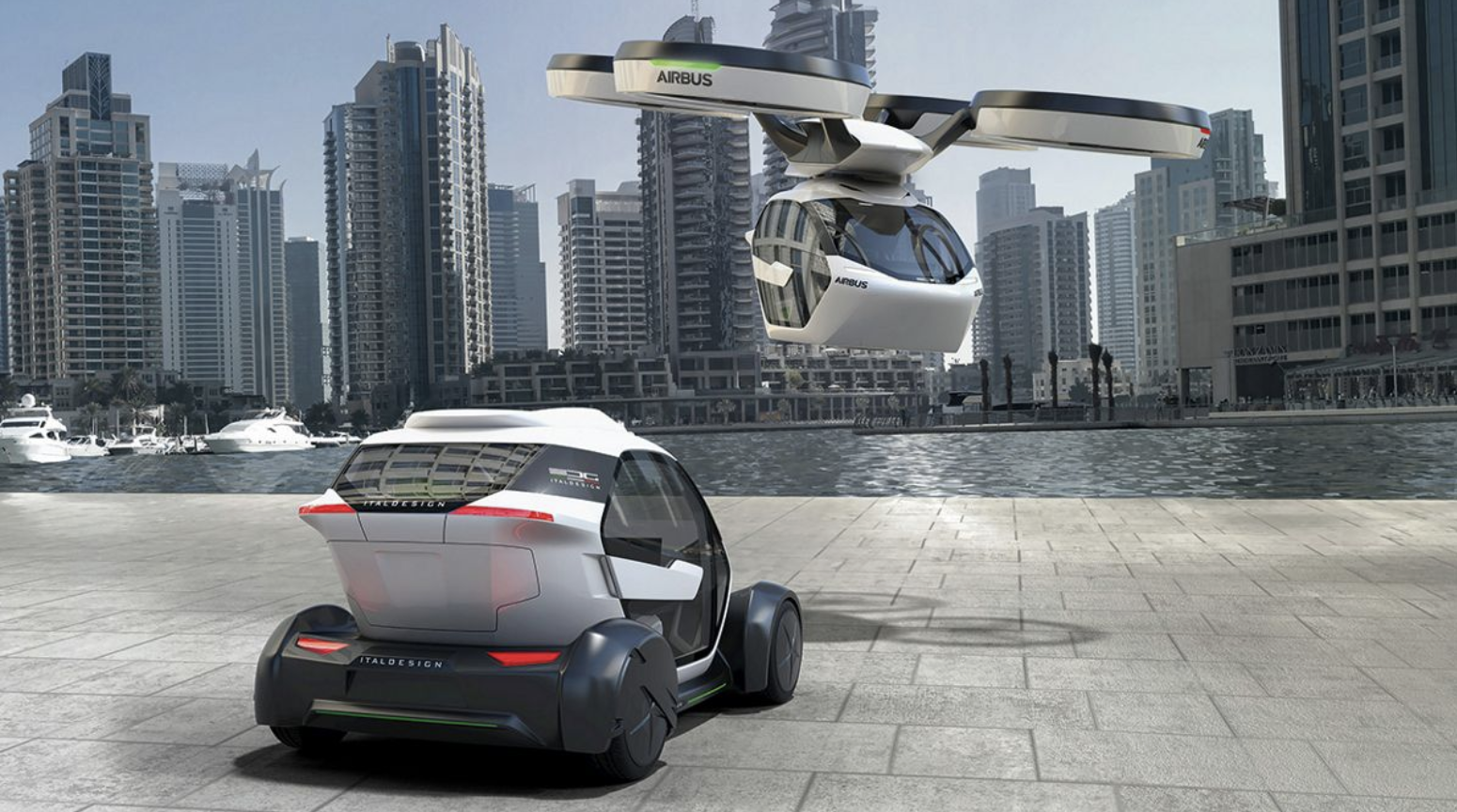Marius Bebesel's CityAirbus team, which is benefiting from tens of millions of euros in development cash from its aircraft manufacturing parent Airbus, aims to have a full-size demonstrator up and flying by the end of 2018.
This is a bit of a science fiction that is becoming a reality now, so it's pretty cool to work on it."
Meanwhile a couple of hundred kilometres away in the small town of Bruchsal, start-up Volocopter's ambition, according to chief executive Florian Reuter, is to become the "the first all-electric air taxi in the world".
The Volocopter has 18 propellers in a distributed circular array above the two-seater cockpit.
"It's all about safety," says Mr Reuter. "Up to nine propellers could stop working and it would still fly."
Designed for short-hop urban flights, the battery-powered Volocopter will have a range of around 16km-32km (10-20 miles), he says, and will eventually be fully autonomous once there's sufficient public confidence.
But this is no pie-in-the-sky fantasy of the company's entrepreneurial founder Alexander Zosel; the start-up has attracted serious money – 30 million euros from big hitters such as the owner of Mercedes-Benz, Daimler, and tech giant Intel.
The craft undertook its first fully autonomous test flight in Dubai in September 2017 - "the first in history", says Mr Reuter - and he envisages commercial production within five years.
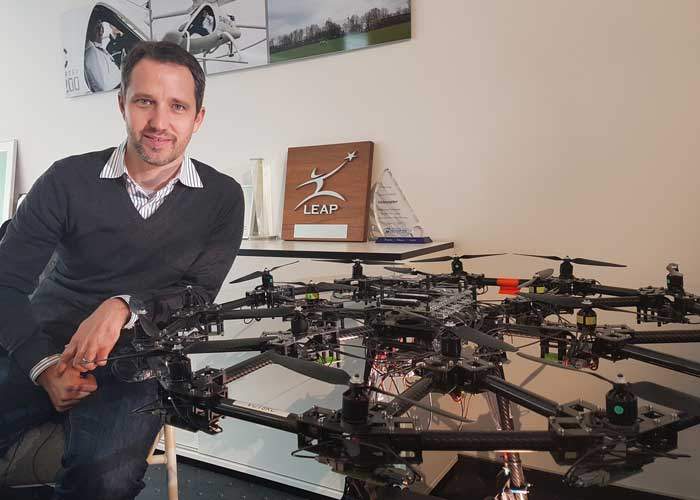
Taking an air taxi will be a routine daily activity in time...We want to democratise flight."
Plenty of other companies are developing sky taxis, including China's Ehang, ride-sharing giant Uber and California-based Vimana.
But will this futuristic vision of urban mobility surmount the formidable regulatory obstacles?
Prof Gray says yes, eventually.
"We could see smaller sky taxis within the next 10 years, once regulation has caught up with the technology. Artificial intelligence will play a huge role in optimised air traffic management."
But others are more cautious.
"By 2022 we'll certainly see some people being transported by air taxis, at least by emergency services," says Prof Harry Hoster, director of energy at Lancaster University.
"But they won't replace car taxis any time soon. There are just too many rules governing airspace and how many aircraft that can be in the air at any one time."
And while battery powered sky taxis promise to reduce localised pollution and ease megacity congestion, he points out that total energy consumption could actually rise as more people use them – as would the number of accidents.
Sky taxis would use double the amount of energy compared with electric cars and have about half the range, Prof Hoster suggests. This wouldn't be an issue for climate change if all the electricity came from renewable sources, but recharging all these electric vehicles - on the road and in the air – could put a huge strain on electricity grids, he says.
Then there's the noise issue. Electric engines are undoubtedly quieter than combustion engines, but collectively, a sky full of clever copters could still make a racket and provoke public opposition.
"They looked at us as a bunch of crazy people!" says Ashish Kumar, co-founder and chief executive of Zunum Aero, a US-based start-up developing a range of hybrid-to-electric planes.
In 2013 when the business was founded, the concept may have seemed far-fetched. But now, the industry is taking electric engines for passenger planes very seriously indeed.
Commercial aviation contributes about 2% to global man-made CO2 emissions, according to International Air Transport Association (IATA) statistics. By 2050, the European Commission wants the industry to have reduced CO2 emissions by 60%, nitrous oxides by 90% and noise by 75%.
This can't be achieved using current technologies, most experts agree.
So Zunum (pictured) - funded by Boeing HorizonX, Jet Blue Technology Ventures and the State of Washington Clean Energy Fund - is one of several firms developing electric engines that promise to reduce the costs, noise and pollution associated with short-haul flights.
Two-seater electric planes are becoming more common with companies like Slovenian Pipistrel and Germany’s Siemens demonstrating their feasibility.
Pipistrel is also one of the companies involved in the 4-seater, German-designed HY4, which is powered by hydrogen fuel cells.
But the challenge is to develop commercially viable electric aircraft capable of taking multiple passengers.
Zunum is currently developing a 12-passenger hybrid-electric plane it hopes will be ready by 2022, while Israeli firm Eviation is designing a nine-passenger pure electric version.

Aviation is finally able to break free of the chains of jet fuel."
Break free of jet fuel? Well, not completely…not quite yet.
A conventional gas turbine will always be required so long as aviation regulators require reserve power for 45 minutes of flight to cover emergencies, admits Mr Kumar.
The limitations of battery power mean electric planes will fly more slowly and at lower altitudes, he says, but this means they will need less maintenance and will not have to be as strong and heavy as aircraft designed to go higher and further.
Light, thermoplastic materials will help make the planes cheaper to make and operate.
"We forecast at least an 80% reduction in fuel costs," he says. Given that the industry will spend more than $150bn (£112bn) on fuel in 2018 (source: IATA), which is about 20% of an airline's total running costs, such savings should prove attractive, Mr Kumar hopes.
On landing, maintenance crew could simply swap the drained batteries with recharged ones.
Larger aircraft capable of carrying 100-plus passengers will need batteries that can deliver 17-20 megawatts of power, says Mr Kumar. "That's a hard challenge".
But it's one that Jeff Engler of California-based engineering firm Wright Electric is determined to overcome. He wants to build an electric-powered passenger airliner the size of an A320 within 10 years. This could carry around 180 people.
Short hop distances of around 335 miles (539km) are perfectly possible in electrically-powered passenger planes, believes Mr Engler.
His engineering firm is working on an electric power unit for a plane that could transport nine people. But he admits that “batteries today are not good enough” – they’re too heavy, they get too hot and they don’t produce enough power.
He’s hoping for a technological breakthrough.
“Every 10 to 20 years a new chemistry comes out, the way lithium-ion replaced nickel-cadmium, for example. Solid state batteries could be the next step, although we’re probably 10 years away from that.”
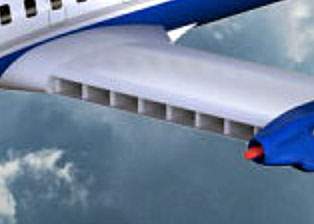
How Wright Electric would house small electric engines on a wing
The advantage of electric engines is that “five to 10 small engines will be just as efficient as one big one”, he says, giving designers many more options over plane design. The turbines could be incorporated into the wing, for example, or placed above the wing at the back of the plane.
Long-haul flights may always be impossible for fully-electric aircraft, unless there’s a radical improvement in battery technology.
Along with many other airlines, low-cost carrier EasyJet is exploring ways to reduce fuel costs and CO2 emissions and has an understanding with Wright Electric, although no formal agreement exists between the two companies as yet.
And aviation industry heavyweights Airbus, Siemens and Rolls-Royce recently announced a joint project to develop a hybrid-electric engine and incorporate it into a BAe 146 short-haul jet by 2020. The E-Fan X, as they’re calling it, will demonstrate the feasibility of the technology and encourage airlines to take it up, its makers hope.
A gas turbine in the back of the plane will power a generator to create electricity for the one electric fan engine complementing three conventional turbofans. Any excess electricity will be saved to batteries and this stored power will be used for take off and climbing.
Such hybrid-electric formations could reduce fuel burn by about 10%, says Airbus, and be much less noisy on take-off and landing and cause less localised pollution.
Dr Frank Anton, head of Siemens' e-aircraft project, says: "We are opening the door to a new world of aviation. This is as disruptive as the gas turbines of the Forties and the turbofans in the Sixties."
Civilian aviation is being disrupted, not by the age-old desires for speed, romanticism and glamour, but by the pressing need to respond to a changing climate. New electric engines coupled with artificial intelligence and autonomous systems will contribute to a more efficient, integrated transport system that is less polluting and less noisy.
That may sound prosaic, but as Prof Gray says:
When I travel somewhere I like this notion that when I finish my journey I feel better than when I started my journey. That’s completely at odds with how I feel today."
Now that would be progress.

